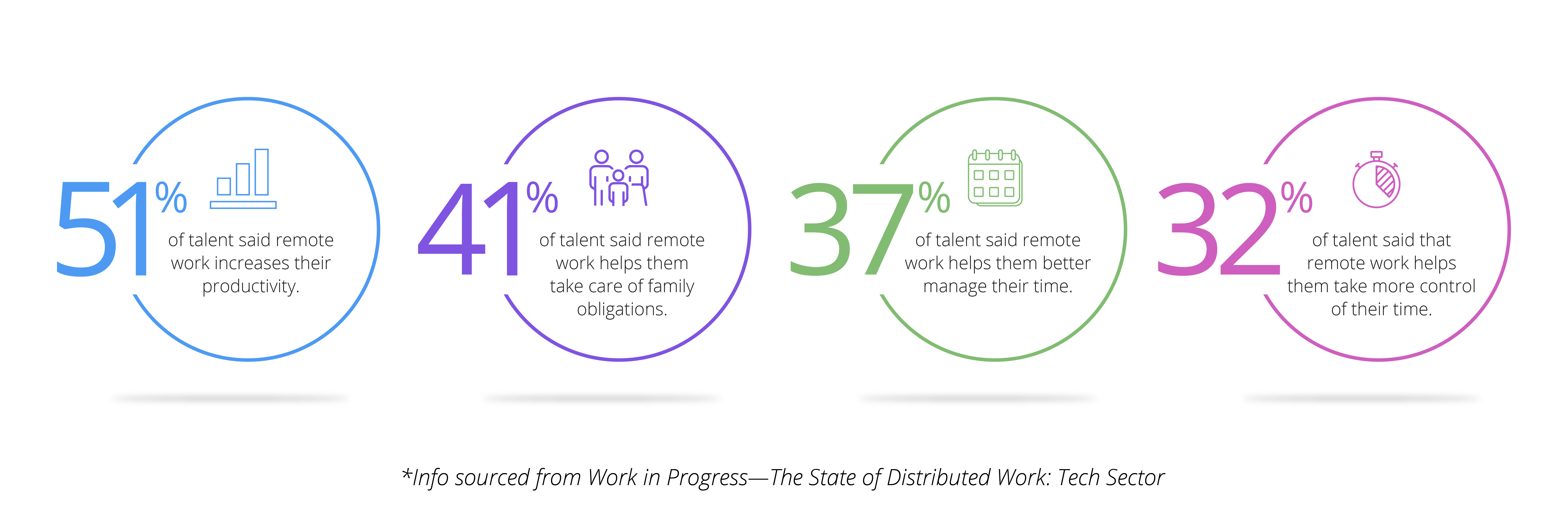COVID-19 has shifted the way we work. Lockdowns created remote office setups, virtual meetings, and now, companies around the world are embracing the benefits of remote work to explore foreign markets and build distributed teams.
Looking at the Velocity Global Work in Progress—The State of Distributed Work: Tech Sector Report, we surveyed more than 1,000 business leaders from the United States and United Kingdom. Of these leaders, more than 800 said they would maintain a fully remote workforce.
Even with these companies and top platforms like Shopify and Wordpress detaching from an office-only policy, many businesses are still resistant to change.
If your company is uncertain about allowing remote work, a remote work proposal can help change your employer’s opinion and grant you the flexibility you’re looking for.
What Is a Remote Work Policy?
A comprehensive remote work policy is a set of guidelines that details every aspect of remote work allowed in your company.
When tasked with trying to develop a new policy, the leaders of your company will coordinate with the Human Resources (HR) department to create proper rules and regulations for working remotely.
The Society for Human Resource Management (SHRM) is a valuable resource for employees who are interested in creating a remote work policy, as well as HR professionals who aim to make telecommuting more viable for their company.
As this sample SHRM remote work policy illustrates, the right policy should outline:
- Objectives
- Procedures
- Eligibility
- Equipment needs
- Security
- Safety
- Time tracking requirements of all remote employees
The policy should also clearly state the company’s expectations for how an individual is expected to conduct business and stay on task while working. This includes communicating on apps like Slack and G-Chat promptly and directly, as well as adding items into a company calendar and showing up on time for virtual meetings.
Which Type of Remote Work Is Right for You?
When you’re creating a remote work policy to propose to your manager, it’s important to note which types of work are allowed.
Typically, many companies will only allow working from home or within a designated location. But if you’re proposing a policy to your manager, you have an opportunity to choose which type of work is best suited for both you and the company. Perhaps having location independence and the ability to work from anywhere is the best fit.
When drafting a remote work policy, use this graphic to identify and explain the type of work that is right for you:

How to Craft a Remote Work Proposal for Your Managers
With this information in mind, it’s important to note other data and statistics in your remote work policy that will help your company understand the positive benefits of remote work, including better work-life balance and competitive pay.
Note the Benefits
In terms of benefits, the Velocity Global Work in Progress Report found that employees prefer remote work. In fact, employees from half of the companies we studied said remote work makes life easier for them.

Discuss Your Why
It’s important to discuss your “why” for working remotely. Perhaps you live far away from the company office and the commute is disruptive to your life. Perhaps you have friends, family, or distant relatives living abroad and want to visit them while working remotely. Perhaps you have concerns about being in close proximity with other people in the middle of a pandemic. Knowing your why is an essential part of helping your employer understand your reasons for working remotely.
Vocalize Your Commitments
When proposing a remote work policy for yourself or your entire company, it’s understandable if your manager and HR representative raise their own concerns. They may ask about your ability to stay committed and productive while working remotely as opposed to the office. Vocalize a clear plan for how you’ll stay focused and engaged, such as the use of task management tools and communication channels.
Highlight Other Successful Remote Companies
Using sharp statistics and conveying personal preferences might help sway your manager and HR representative to let you work from anywhere. But from your company’s perspective, the will of one individual won’t outweigh the goals and vision of the entire organization. That’s why it’s a good idea to bring examples of other companies that have successfully hired and retained remote, work-from-anywhere employees.
For instance, when Brand Designer Sam Butz proposed to move to the United Kingdom and work remotely, his Houston-based branding agency Citrus Advertising faced a difficult decision. How could they move a critical team member to a new country quickly and compliantly?
Using a global Employer of Record (EOR) solution, Citrus Advertising was able to give Butz a full-service overseas transition and onboarding while squaring away payroll and foreign entity compliance.
Don’t Forget to Make a Remote Work Checklist
When proposing your remote work policy, it’s a good idea to create a checklist of items you need to get approved.
This checklist should determine the location of your work, as well as your work schedule. It should also answer questions about office supplies and a remote IT setup. Finally, it helps define expectations around communication and act as a starting point for establishing the proper remote payroll, benefits, tax, and visa requirements for you as an employee.

While each item in this checklist is important to remember, the last two items around payroll, immigration, and taxes are challenging to handle. Employers have reservations about employing talent abroad due to unfamiliarity with foreign employment and immigration laws. Fortunately, that’s where global workforce solutions can help.
Get Support for Your Remote Work Proposal
Even with the best proposal possible, your employer will need a solution to employ you overseas. Partnering with a global employer of record (EOR) is key to making your remote work policy a success.
Velocity Global’s EOR solution enables companies to hire, pay, and offer benefits in over 185 countries. With the support of our EOR solution, you can make your remote work policy a reality.
Want to know more about how our global EOR is revolutionizing remote work? Get in touch.



